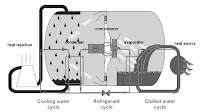The key component of a R718 turbo chiller is the compressor, since water as a refrigerant has some specific features that complicate its application
The use of water as a Refrigerant (R718) in industrial chillers is an environmental friendly new technology, successfully installed over the recent years. This technology has its challenges in all stages of its realization from the development, through design and manufacturing as it is rewarding to an out-of-the-box thinking in the phase of planning the chiller implementation. Water is a natural refrigerant. It is absolutely harmless to man and nature. It is easily available and there are no problems disposing it
after use. Even though water is one of the oldest refrigerants, it requires state of the art technology to use water as a refrigerant in absorption chillers or in compression chillers with steam injection compressors. These techniques are energy efficient as long as there is waste heat or steam available. Much higher energy efficiency can be achieved using compression refrigeration plants with turbo compressors.
The key component of a R718 turbo chiller is the compressor, since water as a refrigerant has some specific features that complicate its application in refrigeration plants with turbo compressors. Since the cycle works under coarse vacuum, the volumetric cooling capacity of water vapor is very low and hence huge volume flows have to be compressed with relative high pressure ratios. So, compared with classical refrigerants like R134a or R12, the use of Water (R718) as a refrigerant requires approximately a 200 times higher volume flow and about a double pressure ratio for same applications. Due to the thermodynamic properties of water vapor this high pressure ratio requires approximately a two to four times higher compressor tip speed, depending on the impeller design, while speed of sound is approximately 2.5 times higher. Reynolds numbers are about 300 times lower and the specific work transmission per unit mass has to be around 15 times higher.
This states challenges for the compressor design. Today they are successfully solved in commercial industrial plants mainly installed in Europe using unique high-performance mixed-flow turbo compressors with or without stationary guide vanes. Other concepts are under investigation, like mixed flow compressors with inducer or pre-runner or axial multistage compressors, promising a higher pressure ratio or a more compact design. High pressure ratios are obtained by the combination of high rpm and large diameter, where the diameter is primarily limited by the available space and manufacturing facility. When compressing water vapor, the tip speed is often limited by the rotor stability rather than by the speed of sound. Working under vacuum the forces exerted by the gas on blades are very small. So the blades must primarily withstand centrifugal forces resulting from their inherent mass allowing for more economic lightweight constructions with extremely thin, mostly straight blades, made of special materials like titanium or composites. These impellers are very much different from usual high-performance impellers. They cannot be milled. They are built of several parts, indicating a challenge for manufacturing and balancing of the high-speed system. Advantageous is the use of variable speed direct-drive motors, working under vacuum and water vapor atmosphere, requiring special bearing, cooling and electrical isolation. Such motors are not readily available and need to be developed for each new power level.
In a R718 turbo chiller system the chilled water, the refrigerant and the cooling water are the same agent (see figure). It is water from the tap not requiring any special treatment. Hence direct heat exchangers are used, allowing initially for a higher overall COP (coefficient of performance), if the system is not hydraulically decoupled from the loop. Further due to the properties of water vapor under
vacuum, such R718 chillers feature a greater gain of COP than conventional chillers, when they are used for higher cooling temperatures. This encourages modern air-conditioning implementations with higher advance temperatures. So retrofitting a R718 turbo chiller is one solution but it is much more energy efficient if the plant design engineer can adapt the user loop accordingly. Industrial cooling
and heat pump application can feature attractive high overall COP as well. Furthermore R718 turbo chillers have a lower noise emission and require no special safety installation concerning drainage and ventilation. R718 turbo chillers represent a cutting edge technology, which is challenging and rewarding. They allow a move towards greener technology with a huge potential for application and
manufacturing even outside of Europe.















%20Desember%202022%20(10).jpeg)






KOMENTAR